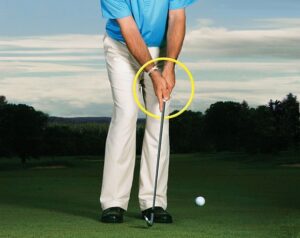Are you losing 10 to 18 strokes a round by not getting your chips within a 1 putt range? Isn’t it maddening when you hit the green in regulation and your ball rolls into the heavy rough just off the green. Or you stub your short chips in the deep rough and have to waste another shot. Wouldn’t you like to learn how to chip it close for more 1 putt greens?
Of course getting it close is the dream of every golfer. We all want to turn potential bogies into pars. It’s not going to happen unless you practice with the right swing to nail every chip. Golfers RX recently listed 3 principles of good chipping so I decided to share our abbreviated version of their list:
1/ Setup with your weight on your leading leg: A chip is designed for direction and distance control, not for power. Weight transfer is not necessary. You avoid a lot of unnecessary movement by starting with the majority of your weight on your leading leg. It also sets you up to finish your swing up your target line.
2/ Control your distance with the length of your backswing: A chip swing is a smooth, accelerating swing, just like a putt. Your rhythm is a comfortable swing so don’t control the distance by swinging faster or softer. Control the distance of your chip shots just like you do on your putts – with shoulder rotation and the length of your backswing. Just let the weight of your club naturally swing through the ball. For a short chip use a short backswing, for a long chip use a longer backswing.
If your ball is buried deep in the rough, take a longer backswing with the same smooth accelerating motion as your club needs more momentum to get through the deep grass.

Jason Carbone demonstrates using most of his weight on his leading foot, locked wrist and hands forward of the club head as he swings through the ball.
3/ Keep a lead wrist rigid through impact. Your leading wrist should be locked and ahead of your club head through impact. Don’t collapse or flip your club head through impact to avoid losing control of your chip. And don’t jam your club into the ground hoping that the ball will pop up.
Chipping can be done with any club depending on the lie of your ball and the runout that you are trying to achieve to reach the hole. Consider using your putter, any iron up to your 60 degree wedge or a hybrid. For short chips, if your ball is sitting in the deep secondary rough within 15 inches of the green, you may be better off putting it, but this takes practice.
Track your progress to improve your chipping by counting your total chips (up to 30 yards) and putts on every hole. For non-professionals this total is far more important to track your progress than total putts. 36 is your target total and keeping under 54 is your goal.
You will never be a great chipper unless you practice with a range of clubs for a range of conditions. It takes practice and judgement for every grass condition and slope run-out on the green. The more you practice the better your feel will get. Make sure that you build confidence with at least 4 different clubs and practice with your GOLFSTR to prevent your leading wrist from flipping when your make your chips. Buy one today at www.golfstr.com
If you like this tip, please click the LIKE BUTTON to spread the word.
And share your thoughts using the Reply box. Love to hear from you.
Your Swing Support Center Advisor: Will Curry


